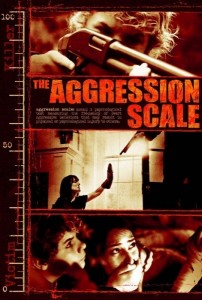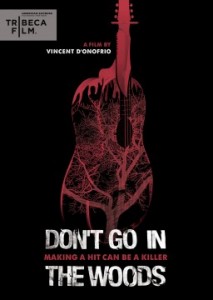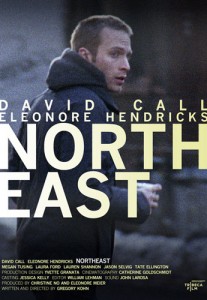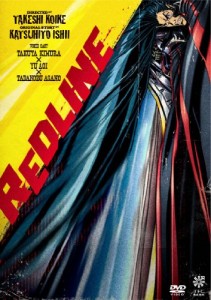
The Aggression Scale

Plot: When Bill (Boyd Kestner) steals money from Bellavance (Dana Ashbrook), he ships his family to the countryside to escape his wrath. Bellavance sends four hitmen (Ray Wise, Derek Mears, Jacob Reynolds & Joseph McKelheer) after him. They’re surprised with the cunning skill of his son, Owen (Ryan Hartwig) and stepdaughter, Lauren (Fabianne Therese), who fight them off.
Review: If you watched “Home Alone” and wondered what it would be like as a straight laced thriller, “The Aggression Scale” is the film for you. Calling it a straight laced thriller is a bit of a stretch. The film delves into the camp zone midway through, which I’m next to certain was intentional. It’s not camp on the level of “Home Alone”, where the pain the Wet Bandits endured was intentionally comical. Lloyd’s henchmen take serious damage here and it can be quite painful to watch (especially the last booby trap).
Though I believe that Steven C. Miller intentionally directed the film with a campy tone, I have a feeling that Ben Powell’s script was more serious. The first half of the film is built up like an average thriller. Bill and his family move to the countryside, with them obviously hiding something from their kids (they’re very jumpy anytime they hear the doorbell). We immediately put two and two together that they stole money from Bellavance, as we see him setting his crew straight before we’re introduced to the family.
Once Bellavance’s cronies arrive, the film drastically changes tone. We learn that Owen, the quiet kid who never speaks, actually has anger issues and is highly skilled in war tactics. He’s essentially Rambo if he were a thirteen year old kid. It’s at this point that Miller realized the film wasn’t going to be taken seriously, so hamming it up (essentially) was the way to go. It’s a wise decision.
This drastic change of tone doesn’t come without it’s faults. There’s the obvious vexatious shifting of gears. This not only makes the viewer uncomfortable with the change for a few minutes (we were prepped to expect a natural thriller), but damages some of the characters. Though Owen benefits, his sister Lauren’s prissy attitude (which is hiding her addiction to drugs and wrist cutting) is all but forgotten. His parents go from distraught individuals to mere afterthoughts. Character development goes out the window for intricate traps.
The only ones who don’t get too harmed from the change are the villains. They’re a bit cheesier now (one comments, in the middle of a hunt, “I just want to get home to my wife, then see my girlfriend”), but it works. Since they had yet to be fully developed (and, outside of Dana Ashbrook’s Lloyd, none really are), they were able to adapt to the new tone. They’re still menacing, but are a bit cheekier now. Miller and the cast find a way to make this work.
I won’t deny that the second half of “The Aggression Scale” is entertaining. The mix of “Home Alone” and “Rambo” is unique and delectable. What prevented me from fully enjoying it was the drastic change of tone. Instead of being half thriller and half camp, Miller should have went full circle with one of them (preferably camp). The two elements don’t blend together and the first half feels wasteful once the second act kicks in.
Final Rating: B-
Bear Nation

Plot: Malcolm Ingram (director of “Small Town Gay Bar”) directs this documentary which focuses on the bear community. This community consists of burly and hirsute gay men who either like those similar to them or are liked by those different than them. The film delves into the many layers of the bear community and the history of it.
Review: What I liked most about “Bear Nation” was that it was about acceptance. The backdrop may have been for gay men (and, in particular, bears), but it can be applied to anybody who feels like an outcast. A message that you may be labeled weird by many, but there’s a group out there who appreciates you. I’ve found that group with this site, the ones that branched from it (so to speak) and the various other online communities I frequent (hi, Gentlemen’s Guide to Midnite Cinema).
That’s how a lot of the men interviewed in this film feel. Like outcasts in the real world, but normal and loved in their community. Especially for those that like bears, but aren’t bears themselves. Most people who finally accept the gay community can’t wrap their head around the fact that some men solely like bigger gentlemen. Malcolm Ingram explores that, while briefly highlighting gay culture and acceptance on the side.
What’s most interesting about this documentary is that the bear community is very diverse. Many people classify bears much differently. Some just see them as big, fat men. Others see them as hairy, gigantic men who are reasonably fit. There are various terms associated with these subgroups (Muscle Bears, Cubs, etc.), which angers quite a few. It’s enthralling to hear each perspective, with the obvious standouts being those who just want everybody to be accepted and loved.
To prevent the film from being a talking head documentary (which is just interviews), Ingram inserts clips from pop culture and various gay events. The parades are only skimmed through and we settle into the conventions about midway through. It’s genuinely heartwarming to see men just being themselves and not having to put on a fake persona. The true joy of this film is in Malcolm’s attention to that.
The film does start to become redundant near the end. I think Ingram noticed this, as he quickly spices things up by including a beefy (no pun intended) interview with his pal and executive producer, Kevin Smith. Smith has been a strong supporter of the gay community, going as far as posing on the cover for a bear magazine (and promoting it on “Late Night with David Letterman”). Regardless of what your feelings are towards him, he comes off as genuine and nice here. He paints the community in a great light, one that I hope becomes the norm as time moves on!
“Bear Nation” is kept at a brief running length (only seventy-seven minutes). This is for the better, as the film started to outwear it’s welcome. It’s not that it’s not enjoyable hearing these men discuss their passion, but it does become redundant (as previously mentioned). That’s a problem that most documentaries run into, but most seem to let it run on for too long instead of mercifully cutting it off. Ingram notices this and stops it at the right moment. Which is great, because I wouldn’t want a fantastic documentary such as this to have it’s rating dragged in the mud due to time issues!
Final Rating: B+
Don’t Go In the Woods

Plot: A young band head to the woods for the weekend to write new songs. Their girlfriends end up surprising them and hope to give them inspiration. If they can write a few good tunes, a record label may be in their grasp. Standing in their way is a psychopath with a sledgehammer who’s hunting them down.
Review: “Don’t Go in the Woods” isn’t a slasher film. Honestly, it’s not even a film. It may be shot like one, but there’s no narrative or character development. Occasionally, these two elements are shoved in, but they come across as forced. It’s clear the intention of this film was to give the band featured a stage in which to perform. This makes the film feel more like a promotional video for a garage band than something worthy of being released by Tribeca.
The reason the film caught my eye was the man who wrote and directed the film. That would be Vincent D’Onofrio, most notable for playing Detective Robert Goren on “Law & Order: Criminal Intent”. The fact that he not only directed a film (this is his directorial debut), but it’s a slasher had me interested. Clearly, a prolific name such as himself wouldn’t simply fall into making a slasher film. There had to be a passion behind it.
Clearly, I was wrong. I hate to call out D’Onofrio and state he put no effort into the film. For all I know, he sunk his heart and soul into “Don’t Go in the Woods”. If that’s the case, I apologize ahead of time for my comments. For the direction and script are afterthoughts to the serviceable, but largely forgettable music on display. Even the killer himself only pops up a few times and feels as if he walked into the wrong movie. Whatever D’Onofrio had envisioned for this film never presented itself on screen.
Since the film is mostly about the band (who, from my recollection, didn’t have a name), I might as well address their musical talents. Or lack thereof, to be precise. To be fair, they’re fine instrumentally. They don’t have a distinct sound, but what they play is easy on the ears. The lyrics and the vocals, however, are a different story. Most of them can’t sing. They show signs of promise, but their voices crackle too much and they can’t seem to sing any high notes. The lyrics accompanying the music don’t do them any favors. They’re as vanilla as store brand ice cream.
That right there is the main criticism of the film. The film is labeled a horror musical, but is mostly the latter. Even then, it’s a poorly constructed one that’s very aimless. The only way to tell the characters apart is by their ethnicity or, in the case of one member, their blindness. The only reason this comes into play is to give the character a trait. It’s never used to great avail, outside of a decent song (which, admittedly, is probably the best one featured).
I honestly hate to call this a film. Most stories have conflicts and gripping characters. I don’t expect much of either in a slasher, but I do want a semblance of something. I’d say that, out of the eighty-three minute running time, seventy-five percent of it is devoted the band performing. Another twenty percent is dedicated to them moping around and suffering from first world problems. The other five percent is the killer stalking them. Only about one percent of all of that is worthwhile.
Final Rating: D-
Northeast

Plot: Unemployed Will (David Call) drifts through life in Brooklyn. He crashes at various friends’ apartments and adds a new woman to his bedpost when loneliness sinks in. As he watches his friends begin their careers and settle down, he attempts to do the same.
Review: I’m willing to cut Gregory Kohn some slack. This is his first film (both written and directed), so I expect some mistakes. At the very least, he’s never self indulgent or thinks his script is much smarter than it actually is. He understands the concept of storytelling and how to manipulate the camera to replicate the emotions his character(s) are feeling. He utilizes the character of Will seemingly as a caricature of himself and his own problems.
Too bad Will doesn’t seem to have many problems. Sure, he’s unemployed, but that never seems to be an issue. He’s never thrown out on the streets and always has food to eat. How about being single, while everybody else moves into the married life? His charm allows him to get many women and he even seemingly strikes up a relationship with one of them. As time went on, I began to wonder what the problem was.
That’s the main issue with “Northeast”. There never seems to be a dilemma for Will to tackle. Kohn would like us to believe there is. What with the lingering camera shots that represent his mundane and dragged out existence. There’s also the constant matter of Will staring blankly while the world passes him by. He watches everybody live a productive life while he takes up space. This would have wrong true more often had it felt as if he was in any danger, emotional and/or financial.
David Call does his best with the role of Will. He shows charisma and a knack for conveying emotion. It’s not his fault his character comes across as one-dimensional. The same goes for the rest of cast, who feel like they’ve been plucked from an assembly. Actresses such as Eleonore Hendricks may imbue their characters with magnetism, but none of them have personalities. They’re all plucked from an assembly line of stock characters and tossed into Will’s life.
I understand that Kohn is trying to be different. He doesn’t want to follow the patterns designed by the Hollywood elite. Yet, he’s still following a stale design. The independent scene has been overrun by productions such as this. So-called examinations of life (usually revolving around those in their twenties) that have characters staring into cameras and waxing philosophically. Kohn avoids the latter, but everything else about this film reeks of familiarity. If Kohn wants to make a successful film, he may have to borrow elements from the Hollywood staples. At least those films usually have conflict.
Final Rating: C
Redline
 Plot: JP and Sonoshee are both entered in the prestigious Redline tournament. Both have dreamed of this moment since they were children. Standing in their way are the other competitors, as well as the President of RoboWorld, who will stop at nothing to prevent the race from taking place. Also causing problems is Frisbee, JP’s mechanic who is in debt with the mob and has strapped a bomb to JP’s car to prevent him from winning the tournament and allowing him to escape his payment.
Plot: JP and Sonoshee are both entered in the prestigious Redline tournament. Both have dreamed of this moment since they were children. Standing in their way are the other competitors, as well as the President of RoboWorld, who will stop at nothing to prevent the race from taking place. Also causing problems is Frisbee, JP’s mechanic who is in debt with the mob and has strapped a bomb to JP’s car to prevent him from winning the tournament and allowing him to escape his payment.
Review: I’m not that familiar with the world of anime. I’ve actually avoided it due to friends who attempted to pressure me into the genre. They would force viewings of shows such as “Naruto” onto me, which I couldn’t stand. Considering bubblegum pop shows such as that seemed to be the main focus of the anime genre, I steered clear. It wasn’t until the past year or so that a few new friends have pointed me in the direction of better anime fare.
“Redline”, Takeshi Koike’s anime version of “Death Race 2000” (an easy comparison to give readers an idea of the production), came heavily recommended by many. They guaranteed me that it would change my tune on anime and give me hope. There was a lot riding on this film, much more than the prestige of winning the Redline tournament.
I’m happy to report that “Redline” did, indeed, change my stance on anime. I’ve now realized that the stories can be fun and mature and that the animation can actually look crisp. The animation here may be the most gorgeous I’ve seen in awhile! Everything moves smoothly and the texture is highly defined. No computer animation is done here. This is all drawn by hand.
The story itself isn’t groundbreaking. The plot between the beginning race (Yellowline) and final race (Redline) is streamlined. I give Takeshi Koike credit for inserting a dilemma in the president of RoboWorld not wanting Redline to take place on his peaceful planet, but do feel the swipes at government are weak. Especially when it comes to the race taking place in a designated area that isn’t ruled by the president, but he still sends his army there to ruin the race itself (which is admittedly entertaining to watch).
Another weak spot isn’t as necessary. That would be the love interest between JP and Sonoshee. Like most action films, it feels forced upon the audience solely to give the women in the audience something to be interested in. I don’t imagine many boyfriends taking their dates to see this, but what do I know? The use of flashbacks to show their history is solely present to attempt to further develop their characters and relationship, but it doesn’t work. We’re already comfortable with the characters and don’t feel the need for them to hook up.
None of these story faults are anything major. They don’t distract heavily from the film, nor do they irritate the viewer enough that all interest is lost. Whenever they seemed to get on my nerves, I’d just sit back and gaze at the beautiful animation, letting it all soak in. What’s nice is that, when it comes to introducing the story arcs into the Redline race, they actually gel well with it. JP and Sonoshee’s relationship doesn’t hinder the race and the government inclusion makes things much more action packed. It makes up for having to slog through some expected story development in the middle.
“Redline” may not be a game changer for many, but it was for me. Despite it’s flaws, the film did what many anime project couldn’t; it wowed me. I was taken aback by the dazzling animation and floored by the stellar races. They reminded me of the “F-Zero” games in how they’re animated and constructed (which is a compliment). “Redline” did the seemingly impossible and made me optimistic about the anime genre.
Final Rating: B
